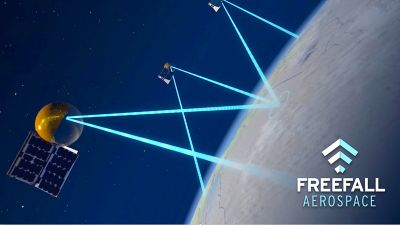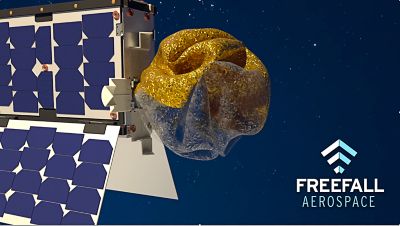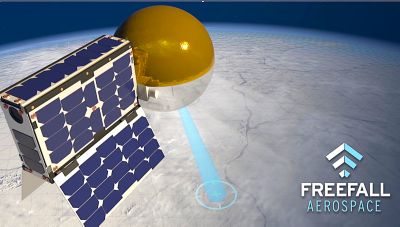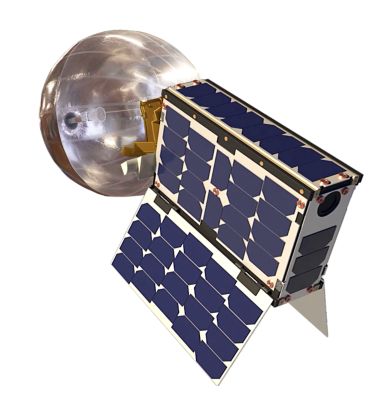-
United States -
United Kingdom -
India -
France -
Deutschland -
Italia -
日本 -
대한민국 -
中国 -
台灣
-
Ansys stellt Studierenden auf dem Weg zum Erfolg die Simulationssoftware kostenlos zur Verfügung.
-
Ansys stellt Studierenden auf dem Weg zum Erfolg die Simulationssoftware kostenlos zur Verfügung.
-
Ansys stellt Studierenden auf dem Weg zum Erfolg die Simulationssoftware kostenlos zur Verfügung.
-
Kontakt -
Karriere -
Studierende und Akademiker*innen -
Für die Vereinigten Staaten und Kanada
+1 844,462 6797
ANSYS ADVANTAGE MAGAZINE
DECEMBER 2021

Transmitting data to and from space in the most efficient manner possible – minimizing weight, power, complexity, and cost – is and always has been one of the fundamental challenges facing the entire space industry.
FreeFall Aerospace of Tucson, Arizona — a technology spinoff company from the University of Arizona— has developed a new type of antenna that promises to meet this challenge in a unique way. FreeFall utilizes an inflatable structure that can be packed inside a small satellite and deployed in space. This provides a large aperture that can transmit or receive vast amounts of data with very low mass and power compared to traditional antenna systems. The FreeFall antenna is essentially a balloon, half transparent and half metallized, that captures radio signals and for efficient communication. Allowing the reflector to take a spherical rather than a parabolic shape results in very low-risk deployment, a sphere being the natural shape that any inflated object tends to achieve. The resulting system has the potential to provide orders of magnitude increase in data rate at very low cost.
FreeFall engineers have made extensive use of Ansys HFSS full-wave electronic simulations to analyze the performance of this system and develop detailed designs without the need for expensive and time-consuming hardware experiments.



The company obtained HFSS through the Ansys Startup Program making simulation software available at significant discounts to startup companies. Ansys Elite Channel Partner Phoenix Analysis and Design Technologies (PADT) steered the FreeFall team to the Ansys Startup Program, which resulted in a FreeFall–Ansys partnership.
“I can't imagine how we or any similar company could have done this without tools like Ansys HFSS,” says Doug Stetson, Co-founder, President and CEO of FreeFall Aerospace. “I guess back in the day, you would build and test and test and test, but it would take a tremendous amount of time to build different antenna types, test them, and tweak their designs physically to get the performance you want. We're able to do that all electronically now using HFSS, and it's a tremendous time and money saver —it's enabling for a company like ours.”

Spherical antenna prototype
Simulating Spherical Antennas
The symmetry of the spherical antenna is the key to FreeFall’s technology.
“The symmetry gives a sphere essentially an infinite number of directions that you can aim the beam”, says Terrance Pat, RF Design Engineer at FreeFall who received his doctorate under Walker. The ability to efficiently steer the radio beam without the need to physically turn the spacecraft or antenna is one of the keys to FreeFall’s approach. HFSS capabilities for rapid meshing and parametric adjustment of quantities such as phase and amplitude lead to a highly efficient process for antenna simulation and design.
“Ansys has made the process of determining the proper mesh more or less automated.” Pat says. “So it's as easy as designing your antenna and defining the appropriate boundary conditions. About nine times out of 10, you can go with the default meshing, which is determined automatically.”

Simulated FreeFall Aerospace RF emission pattern using Ansys HFSS
In simulating the antenna, Pat says he uses alternative computational methods to save time, such as the integral equation (IE) method, which solves massive equations using integrals instead of matrices, and the shooting-and-bouncing-ray (SBR) method, which is based on geometric optics.
“When you have a reflector that is electrically very large, you can approximate the field impinging on the reflector as geometric rays, which are almost parallel.” Pat says. And so you can use ray tracing to get back the scatter fields from the reflector. And the plus side of using SBR in those situations is that it’s GPU friendly. You can use a graphics card to accelerate the computation, which really helps.”
Using HFSS for Engineering and Sales
Currently, the inflatable reflecting spherical antenna is in the prototype stage, with several interested potential customers monitoring the company’s progress. Stetson has found that HFSS simulation results are key to keeping these potential customers informed.
“We use HFSS not only for our design but for communication with our customers,” Stetson says. “They give us particular specifications on the type of radio beam output that they want to meet their needs. We have to show them that we have designed a system that will meet those specifications, so the output of HFSS is critical. We can show them in a graphical sense exactly what they're going to be getting from our design.”
FreeFall Aerospace is currently working with Rincon Research in Tucson and students from the University of Arizona to develop the CatSat mission (named for the UA Wildcats). CatSat is a 6U CubeSat that was selected by the NASA CubeSat Launch Initiative mission and will fly in mid-2022. It is designed to demonstrate FreeFall’s inflatable spherical reflector technology as well as perform a number of science experiments, all led by students and faculty of the University of Arizona.
“It's going to be very exciting,” Stetson says. “We’re proud to be part of this all-Arizona spaceflight mission and see our technology in action.”
Los geht's
Wenn Sie mit technischen Herausforderungen konfrontiert sind, ist unser Team für Sie da. Mit unserer langjährigen Erfahrung und unserem Engagement für Innovation laden wir Sie ein, sich an uns zu wenden. Lassen Sie uns zusammenarbeiten, um Ihre technischen Hindernisse in Chancen für Wachstum und Erfolg zu verwandeln. Kontaktieren Sie uns noch heute, um das Gespräch zu beginnen.










